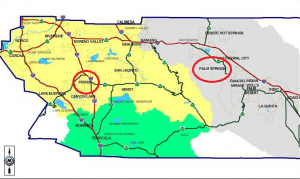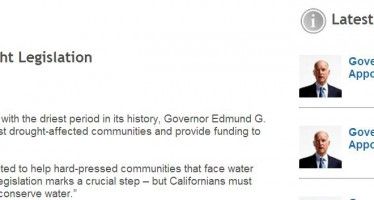Sen. Boxer: Conservation would solve drought

 Can California’s zero-sum water wars only be resolved by a system of stern water conservation? That’s what California U.S. Senator at large Barbara Boxer left as an unanswered question at a March 20 Palm Springs water symposium on the theme “Running Dry.” Video here.
Can California’s zero-sum water wars only be resolved by a system of stern water conservation? That’s what California U.S. Senator at large Barbara Boxer left as an unanswered question at a March 20 Palm Springs water symposium on the theme “Running Dry.” Video here.
Boxer quoted President Obama from his February visit to drought-plagued California. He said Americans should stop thinking of water as a “zero-sum” game.
A zero-sum game is one in which there’s only one winner, and everybody else loses. By contrast, a “win-win” game is one in which, potentially, everybody could win.
Boxer said we’re going to have to think about a different kind of game. The only other game Boxer talked about is where everyone sacrifices by conserving even where it may be unnecessary.
In her speech, Boxer praised the Metropolitan Water District of Southern California for spending $3 billion in groundwater storage and recycling projects since 2009. According to Boxer, MWD serves 5 million more people with the same amount of imported water.
But this doesn’t answer the question of whether conservation can equip California, especially state farmers, for severe droughts, and can grow local economies. California has had mostly voluntary water conservation policies of curtailing water usage by 20 percent.
However, some local governments have taken conservation further by policing and fining those who water lawns on certain days or hours of the day.
And Gov. Jerry Brown’s emergency drought legislation proposes to use state law enforcement powers for the first time ever in California to crack down on those farmers who overdraft local groundwater basins. Until now, self-policing, adjudication and local regulation have worked.
Yet farmers are also the rechargers of groundwater basins, not mere scofflaws.
Enforced conservation
Should Boxer and Obama’s call for enforced water conservation be implemented, ironically it would be her neighbors in Northern California — she hails from Marin County — that would suffer the most. They mostly have not even had to install water meters. Now, the City of Sacramento is already in the process of installing 110,000 water meters by 2025.
Many Northern Californians oppose the $11.1 billion water bond on the November ballot, Gov. Jerry Brown’s proposal to construct twin water tunnels in the Delta, and even the Bay Delta Conservation Plan. But even if Northern Californians could stop such projects, they could end up the biggest losers anyway under a strict water conservation regime that forces them to give up their local water resources by forced abstinence.
 Palm Springs oasis made from dams and water transfers
Palm Springs oasis made from dams and water transfers
Palm Springs is a paradoxical setting for the drought symposium promoting more water conservation. It gets just 5 inches of rainfall a year on average and depends on groundwater for 30 percent of its needs in an average year and 60 percent in a dry year.
Its famed golf courses mainly depend on groundwater, not expensive imported water. The local groundwater basin had 1,312,440 acre-feet of water storage as of 2012, but was in overdraft of 3,400 acre-feet for 2013 and 2014 due to decreased state water allocations.
Palm Springs gets the remainder of its water in a roundabout manner from the State Water Project.
Instead of having to build a pipeline from the state-owned Perris Dam in Riverside County, Palm Springs exchanges its state water allocation with the Metropolitan Water District of Southern California. So MWD gets Palm Springs’ state allocation of Northern California water. In turn, MWD provides an equal amount of water to Palm Springs through its nearby Colorado River Aqueduct.
The water transfer of state water for Colorado River water avoids having to build a 35-mile pipeline between Lake Perris and Palm Springs. (See the circled areas in the nearby map.)
However, Palm Springs paid the standard cost of $159.88 per acre-foot of water for 2013 from the State Water Project even though it gets Colorado River water. Colorado River water has a high concentration of calcium carbonate requiring additional treatment.
Palm Springs is an example of how building dams, reservoirs and aqueducts; and making water transfers, not water conservation, have brought about economic growth in Coachella Valley. Bringing imported water to Palm Springs has allowed the development of a large retirement economy from people all over the United States and Canada. Many other cities in the Coachella Valley have struggled because they have no local economic base.
In accordance with state policies, Coachella Valley has enacted a 20 percent per year voluntary water conservation target.
Waterless Water Conservation Bonds
After spending almost $24 billion on water conservation projects and programs since 2000, California’s water system only has about six months of real water storage. That large amount of money could instead have built the proposed $24 billion Delta twin tunnels to assure water supplies for farmers and cities south of the Delta.
Water conservation is the only policy option in a drought when there is thin water storage. Otherwise, massive funding of water conservation projects in California has failed to prepare it for a prolonged and deep drought.
This is an election year, so not much likely will get done. Even the $11.1 billion water bond, mentioned above, likely will be delayed again by the Legislature because of almost certain voter disapproval. It already was pushed off the 2010 and 2012 ballots.
But 2015 will determine if California is going to abandon the water conservation policies it put into place after voters rejected the proposed Peripheral Canal in 1982. The canal was pushed by Brown during his second term as governor. The new Delta tunnels, assuming he wins re-election November, would be pushed during his fourth term.
Since 1982, California’s population has increased by 15 million, to 38 million. That’s a 65 percent boost. Eventually, the state’s drip-drip inadequate increase in water will have to be solved. Residents will have to decide whether to use Boxer’s mandated conservation — or an expanded system of reservoirs and canals combined with more voluntary conservation.
Related Articles
Gov. Brown announces re-election bid under rain
Last Friday, Gov. Jerry Brown officially launched his re-election campaign. Of course, filing the paperwork was a formality for a man
Is Caltrans too car-centric?
Gov. Gavin Newsom may have to step in to resolve a dispute between a state agency and a high-profile lawmaker
CPUC's Peevey Blows Smog at Hearing
MARCH 16, 2011 By KATY GRIMES In it’s annual update to the Legislature, the California Public Utilities Commission offered plenty




